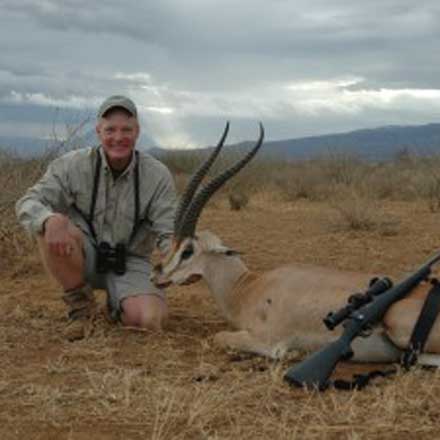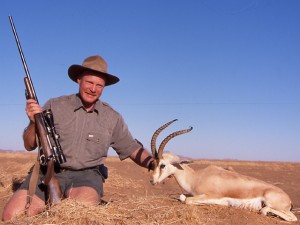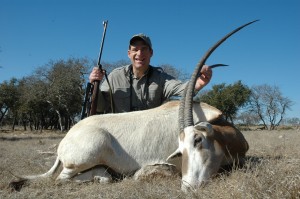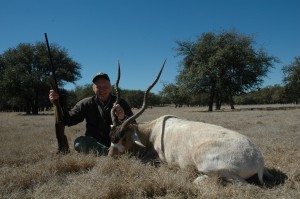
Just 30 years ago, the white, or scimitar-horned oryx, roamed the desert of northern Chad in the thousands. His two buddies, the twist-horned addax and the large-bodied, short-horned dama gazelle were nowhere near as prolific, but they still occurred in very good numbers. When Libya invaded Chad, the Libyans machine-gunned the herds and trucked the meat back to Tripoli- very efficient. This was probably the last stronghold of Africa’s desert antelope in Africa, but all three species are found on private ranches in Texas. Since all three hail from North Africa, and all three are genuinely endangered in their homelands, they are often referred to as the “three amigos.”
Actual numbers are elusive, but at peak there were probably 10,000 scimitar-horned oryx in Texas, somewhat less addax, and probably just a few hundred dama gazelle. All three species are at or very close to extinction in their native range. The Sahara is huge, but there have been no verified sightings of these animals in the wild in many years.
However, oryx from Texas have already been returned to Africa where they are breeding in protected enclosures in hopes that the political climate will someday allow a safe return to the wild.

With native populations seemingly gone, it would seem that the existence of healthy populations of these animals in Texas—or anywhere else—would be a good thing. Here’s the way it has worked. Surplus males have long been harvested by hunters. Numbers available are not large, and prices have always been fairly high, certainly when compared to more common and plentiful non-native species like axis deer and blackbuck antelope. This places value on these animals which means that surplus breeding stock, not just trophy males, also has value, with ranchers actively investing in these animals to start new herds.
I won’t make any effort to glorify the hunting. It has generally not been free range, though with these herd animals, it isn’t necessarily easy. The market is not large, but neither is the supply. Some hunters desire these animals for their own intrinsic beauty. Others, well, I have all the other African oryx from Africa, but neither white oryx nor addax (a fairly close...
relative)

will ever again be hunted on native range. I wanted these animals to round out the grouping of African oryx. I paid for the privilege, and while the experience didn’t compare with a safari to the edges of the Sahara, both hunts were pretty good. Given time, I may well have taken a dama gazelle. Although short in the horn, it was the largest of Africa’s gazelles.
I was fortunate to hunt the small dorcas gazelle in Chad—exactly where the three amigos once roamed. It would have been nice to someday have the larger dama to go with it, but I’m sure now that this will never come to pass.
You see, anti-hunters have clearly stated how they would rather see these species totally extinct than have them legally hunted in Texas. Apparently, the U.S. Fish and Wildlife Service agrees because after April 4th, 2012, it will no longer be legal for Texas ranchers to hunt or sell these three species. There is some potential for a permitting process, but it remains to be seen how onerous this will be. This sad situation has received very good and quite balanced coverage on both liberal (CBS, 60 Minutes) and conservative (FoxNews) networks. The decision doesn’t seem to make sense to anyone except the most radical anti-hunters.

Basically, value is being removed from these species along with all incentive for maintaining herds. Well, okay, sheer altruism will remain, but in a ranching environment where grazing is like hard currency, choices will be made between the Three Amigos and other animals that are able to pay their way.
During the last days of legal hunting, prices are going back and forth, but ranchers have seen this coming for a long time. So the fire sale has already been held, and trophy-quality males are getting scarce. Breeding herds, well, they have no value at all. Not to ranchers and not to hunters. A year ago, there were about 10,000 white oryx in Texas. People in the business—ranchers and...
outfitters—predict the number will fall to below 2000 within the next year. The other two species will follow suit, with the scarce dama gazelle nearly vanishing.
I fully recognize that non-hunters don’t understand hunters and our passion for our sport…and I certainly recognize that anti-hunters not only don’t understand us, but actively oppose all that we stand for. But the primary reason these animals existed in Texas in such healthy numbers is because they had value to hunters, and thus to ranchers. So I guess this is a big win for the anti-hunters…but the real losers are the three amigos.